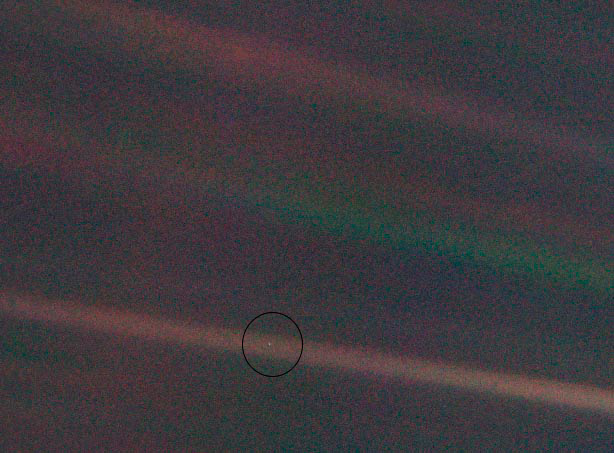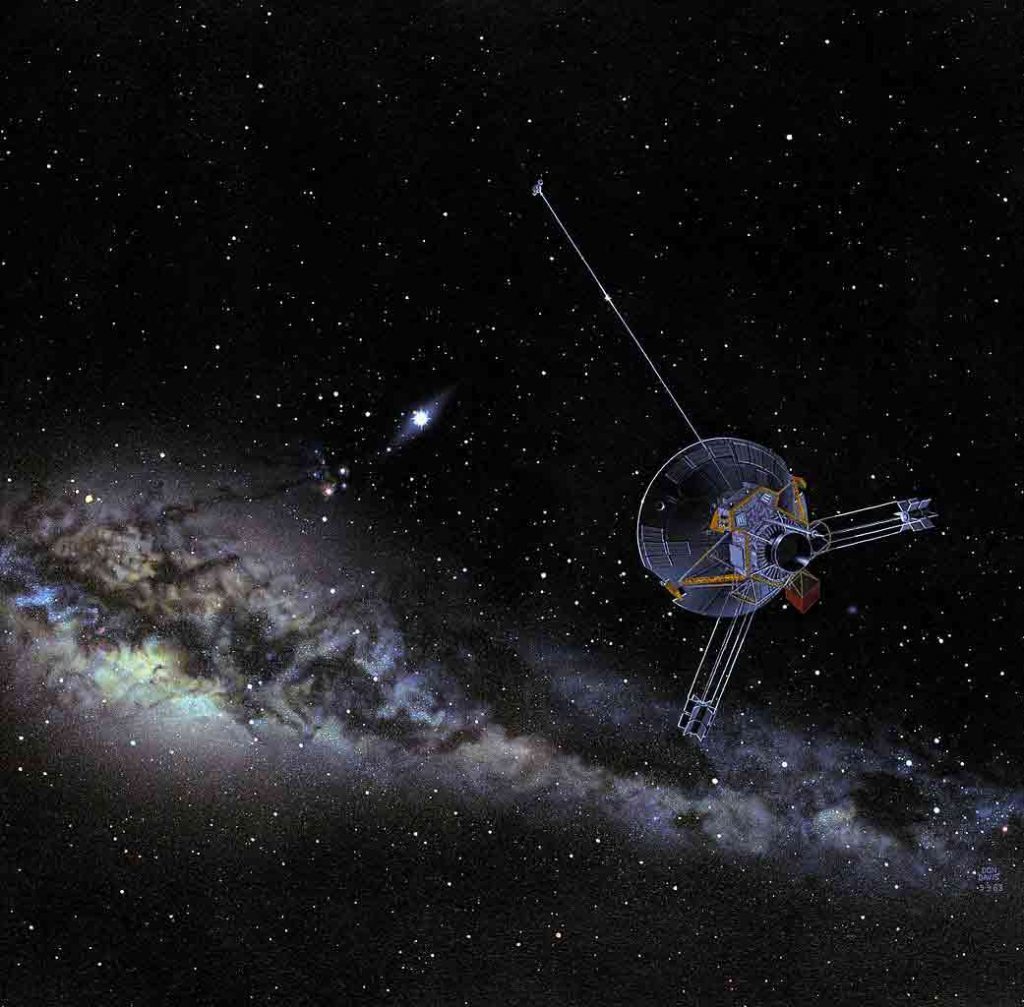“Consider again that dot. That’s here. That’s home. That’s us […] a mote of dust suspended in a sunbeam.” The astrophysicist and popularizer Carl Sagan wrote these words inspired by a photograph of the Earth taken on February 14, 1990 from a distance of 6 billion kilometres. The image, dubbed Pale Blue Dot, was obtained by the Voyager 1 probe on its path to the confines of the Solar System.

The photo shows a background in which the Earth is barely distinguishable, a pale speck occupying only 0.12 pixels of the 640,000 that make up the image. Due to an effect of the Sun’s reflections in the camera, the dot appears to float in a beam of light. Sagan had a special motivation for this photograph, as indeed it was he who suggested that Voyager 1 turn its camera around to take this long-distance selfie of the Earth. The images were transmitted back to Earth by radio over three months, at a rate of five and a half hours per pixel.
The first human being to lay their eyes on this historic document was the planetary scientist Candice Hansen, then at the Voyager mission imaging team at the Jet Propulsion Laboratory of NASA. “I was sitting at my desk, reviewing the pictures we had received that day,” says Hansen for OpenMind. In the photographs of the Solar System, the scientist easily identified Uranus and Saturn, but moving the camera towards the inner planets, the effect of the Sun dirtied the images; the presence of the Earth was not obvious. “Then I saw a bright spot in a beam of reflected light, and I quickly got the other two colours to see if it was there, and it was.” “Then I was sure,” continues Hansen. “And that day, and even now as I write these words, a chill runs down my spine. It is so exciting to see our planet from so far away…”
On 14 July 2015, NASA’s New Horizons probe became the first human spacecraft to fly past Pluto, culminating the mission with the farthest object of study from Earth. The data collected by New Horizons has provided knowledge of a world that had previously been Terra Incognita, from its detailed appearance—including a striking heart-shaped blob—to its still-active geology, which revealed an unexpectedly diverse world, with mountains of ice, frozen methane skyscrapers, solid nitrogen glaciers, cryovolcanoes and even a possible liquid saltwater ocean beneath its surface, coupled with the likely presence of carbon, the basic building block of life. After its encounter with Pluto, New Horizons continued on to Arrokoth, a 36-kilometre-long, snowman-shaped trans-Neptunian object in the Kuiper Belt. On 1 January 2019, the probe completed its closest approach to the object.

New Horizons will continue on its trajectory to the outer reaches of the Solar System, for which it still has fuel until the 2030s. However, it is not the most distant spacecraft from Earth. Four veteran probes are also currently continuing their journeys into interstellar space: Voyager 1 and 2, and Pioneer 10 and 11. The latter two, designed as a kind of dress rehearsal for the Voyager mission, were launched in 1972 and 1973 respectively, and successfully completed their missions to Jupiter, Saturn, Uranus and Neptune. They are still travelling, though no longer in contact with Earth. In June 2021, Pioneer 10 was estimated to be about 19.4 billion kilometres from Earth, while Pioneer 11 had travelled almost 15.7 billion kilometres from its home world.
The two Voyager spacecraft lifted off in 1977 with the aim of examining the outer planets of the Solar System. Voyager 1, the faster one, overtook Pioneer 10 on 17 February 1998, and has since become the furthest human emissary from Earth. On 25 August 2012, the probe left the Sun’s domain to enter interstellar space, a fate followed by its twin on 5 November 2018. Both are still active and in contact with Earth. As reported on the mission’s real-time website, in June 2021 Voyager 1 was already more than 22.765 billion kilometres away, and its sister, which has overtaken Pioneer 11, was more than 18.9 billion kilometres from the Earth. In 2023, Voyager 2 will overtake Pioneer 10 to become the second furthest probe, but it will never overtake its sister. Given the relative speeds of the spacecraft, New Horizons will probably eventually overtake both Pioneers, but this will be in the 22nd century, and it will never catch up with the two Voyager spacecraft.

The five spacecraft will continue to roam the universe, in principle forever, since in space they will suffer hardly any deterioration. “There are cosmic rays, gamma rays and so on, but they should remain intact,” says Hansen. And on these journeys into eternity, several of the probes are equipped with messages from Earth, should they fall into the hands of other beings on their long pilgrimage. The Pioneer spacecraft each carry engraved plaques depicting human figures, our location in the cosmos and the path of the probes, all with reference to the hydrogen atom as the universal scale. For their part, the Voyager messages are auditory as well as visual, with images, sounds and music of the Earth, all stored on gold-plated copper phonograph records (stylus included) using analogue record player technology. These messages are available in digital format at goldenrecord.org. The exception is New Horizons, which carries several symbolic objects on board, but no messages to the stars.

Sagan was also one of the main driving forces behind these messages reaching out to the infinite. The scientist died in 1996 but his work will survive on this planet and beyond. Hansen emphasizes that in the times of the Pale Blue Dot “the Cold War was still intense between the USA and the USSR.” “We lived with the threat of nuclear war,” she recalls. “I think Carl [Sagan] felt that the mission of the image was to show that we are all together on this beautiful world. Today I think that the meaning of the picture is the same, but we face a different threat, climate change. Today, as then, we need to understand that we are all citizens of this planet. It is our only home.”
By Javier Yanes, for Ventana al Conocimiento (Knowledge Window)
@yanes68
Comments on this publication